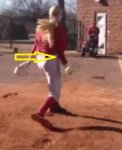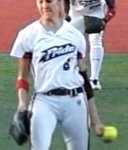Couple comments on this topic.
I used to teach stepping/striding across the PL. It does three things: 1) it sets up some "throwing angle" which IMO creates one more variable for the hitter to deal with 2) it encourages IR which is especially great for downward or horizontal moving pitches. 3) for a horizontal pitch like a curveball it really helps give the illusion of massive ball movement.
Now rather then teaching a step across I encourage the pitcher (RHP) to start with their foot position more to the right side of the rubber (see Doug Gillis's starting position in video above).....from this position the pitcher doesn't really need to step across....they simply perform a normal straight stride which actually sets up the angle. This method eliminates the potential for the pitcher to get out of balance because of the cross stride action.
One other potential advantage to this starting foot position......in the women's game it is becoming increasingly prevalent to throw inside or to throw what is known as "backdoor".....this added throwing angle certainly helps these type of pitches.
Relative to the Monica Abbott video clips....her "step across" IMO would be more to the extreme end of the spectrum....if your DD is being encouraged to step across more than what you see Abbott doing I would guess it will result in some out of balance issues.
Many instructors teach their students to stride in the direction they are throwing......IMO that is less then optimal.....that leaves almost no throwing angle. Visualize trying to throw a curve when striding in the direction you are throwing....not much space left for a curving action to catch the edge of the zone.
My general rule is to stride the opposite direction you are throwing...."all things in moderation".
I used to teach stepping/striding across the PL. It does three things: 1) it sets up some "throwing angle" which IMO creates one more variable for the hitter to deal with 2) it encourages IR which is especially great for downward or horizontal moving pitches. 3) for a horizontal pitch like a curveball it really helps give the illusion of massive ball movement.
Now rather then teaching a step across I encourage the pitcher (RHP) to start with their foot position more to the right side of the rubber (see Doug Gillis's starting position in video above).....from this position the pitcher doesn't really need to step across....they simply perform a normal straight stride which actually sets up the angle. This method eliminates the potential for the pitcher to get out of balance because of the cross stride action.
One other potential advantage to this starting foot position......in the women's game it is becoming increasingly prevalent to throw inside or to throw what is known as "backdoor".....this added throwing angle certainly helps these type of pitches.
Relative to the Monica Abbott video clips....her "step across" IMO would be more to the extreme end of the spectrum....if your DD is being encouraged to step across more than what you see Abbott doing I would guess it will result in some out of balance issues.
Many instructors teach their students to stride in the direction they are throwing......IMO that is less then optimal.....that leaves almost no throwing angle. Visualize trying to throw a curve when striding in the direction you are throwing....not much space left for a curving action to catch the edge of the zone.
My general rule is to stride the opposite direction you are throwing...."all things in moderation".







